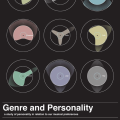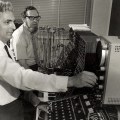When the mothership descends on Wyoming, in the climactic scene of Stephen Spielberg’s 1977 film Close Encounters of the Third Kind, the usual trappings of invasion are conspicuously absent. There are no laser guns, no pronouncements of interstellar warfare. The aliens don’t unravel some cosmic decree, claiming the Earth. Instead, they make first contact with a melody—one that, with the help of an Arp 2500 synthesizer, the human welcoming committee sings right back: bum bum bum bum bum. Like mathematics, music is often considered to be a “universal language.” This has some basis in science: the human brain hums with complex rhythms created by the pulse of synapses as they convey signals from neuron to neuron. We are just beginning to learn that these rhythmic oscillations have a hand in all manner of cognitive functions—information transfer, perception, motor control, memory. And music affects the limbic system, a relatively ancient part of the human brain, and one that we share with much of the animal kingdom. But what of life beyond Earth? Is music really capable of bridging the far wider gap between human and extraterrestrial intelligence? We’ve exploited this belief in fiction and reality alike; Close Encounters of the Third Kind’s tonal hello is an example, as is NASA’s Voyager Golden Record, a mixtape of musical greetings from Earth, from Chuck Berry to Bach’s Brandenburg Concerto, tacked onto the two Voyager probes, launched in 1977 and now the manmade objects furthest from Ear—119,000,564,128 kilometers away as of this writing. Of course, it’s likely aliens would take the Voyager Golden Record for a piece of space garbage; Carl Sagan himself called it a “symbolic statement rather than a serious attempt to communicate with extraterrestrial life.” Sagan was right: the notion that music could serve as a tool for communicating with aliens is predicated on too many false assumptions. First, the idea that an extraterrestrial race might have evolved along the same lines as us, with a built-in apparatus for translating frequencies into meaning. Like any speculation we make about the physiognomy of extraterrestrials, it’s flimsy. We have no evidence to prove that parallel evolution on an interstellar scale is possible, save the diversity of ears and eyeballs on Earth. Even on our own planet, living beings experience sound in a staggering diversity of ways. Not all life wanders down the same path: most reptiles sense vibration through the ground with their bellies, dolphins hear through an external “ear drum” on either side of their head, whales call to each other across the reaches of the sea with complex moans and clicks—incidentally, the Voyager Golden Record carried whale songs into outer space—and bats echolocate in the blind. If by some stroke of luck, extraterrestrials do recognize sound, we are still left with the problem of aesthetics and meaning. Would our human music, with its impossibly wide range of tonal variations, be pleasing to the alien ear? Would it contain any useful information? Just as dolphin clicks are inscrutable to us, might a Bach concerto reverberate as an offensive screech to the aesthetic palate of another, far more foreign, intelligence? That said, if aliens are interested in us, they have plenty of source material. We’ve been weeping radio waves into space since the dawn of the modern age, and this garble could tell an intelligent race far more than we realize, just as a perusal of one’s own unedited search history often reveals a very clear form of one’s personhood, fears, and desires—to say nothing of the limits of one’s intelligence. The result isn’t necessarily flattering. In Carl Sagan’s 1985 science-fiction novel Contact, aliens from the Vega star system make contact by bouncing back to Earth the first television signal strong enough to escape our planet’s ionosphere: Adolf Hitler’s opening speech at the 1936 Summer Olympics. Even an intentional message, like the Golden Record, might travel though the universe for millennia. We may not be around by the time it reaches the intended audience. And on the rare chance that we haven’t destroyed our planet and ourselves along with it, we will definitely have made evolutionary leaps in the composition of music. Consider, after all, the difference between Incan pan flutes and Einstürzende Neubauten; that’s only a thousand years of relatively eventless human history. Which leads us, finally, to the problem we’ll tackle in more depth in next week’s column: is it possible to future-proof music? To create something timeless, not only for a handful of generations, but for the entire spread of the human race, and beyond—something which might represent our sentience to the mute audience of the cosmos? Consider the only place where this question is regularly addressed—science fiction. When tasked with creating music that might reasonably pass for something composed in the distant future, we tend to come up short. The Mos Eisley Cantina in Star Wars, the mutant diva in The Fifth Element, the infamous “cave rave” in The Matrix Reloaded: like everything in science fiction, they tell us far more about the present than the future. Musical trends have a short half-life; archaeologists could easily use the musical sequences in our science fiction films as a method of carbon-dating their precise date of release. So the simple answer to our question—can we make future-proof music?—is no. But like all impossible questions, it’s worth asking, if only for the tour of unlistenable, posthuman, cosmic, and science-fictional sounds it affords the serious armchair thought experimenter. Bring your headphones, and I’ll see you in the future.
|
|
|























